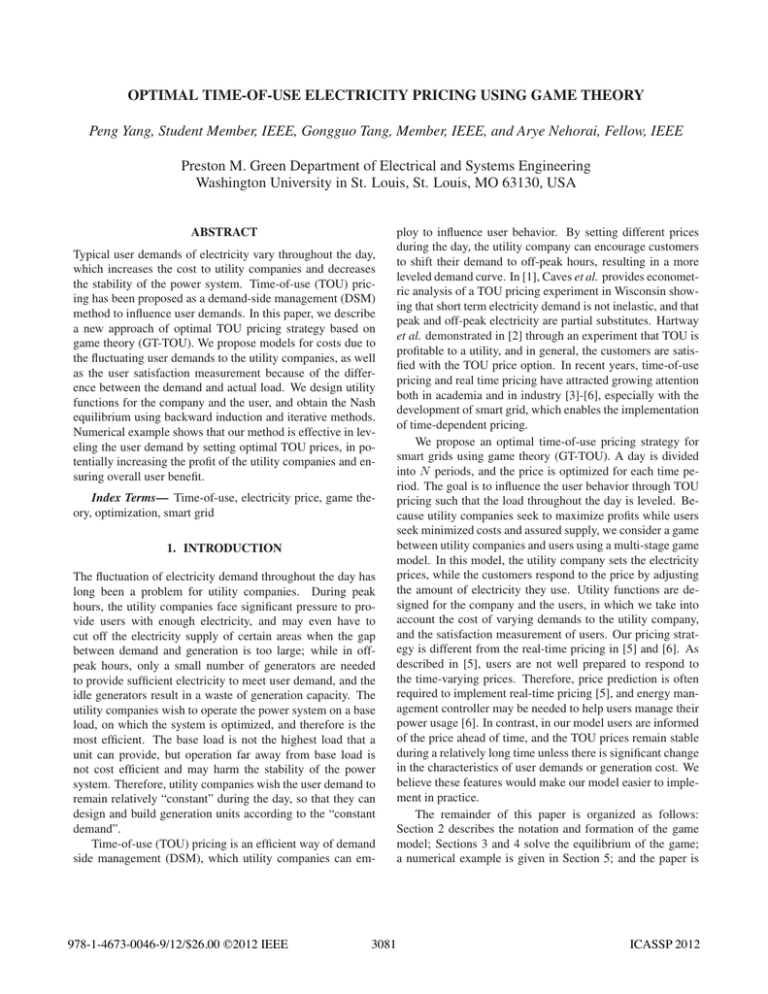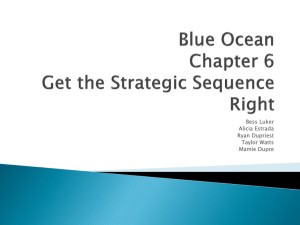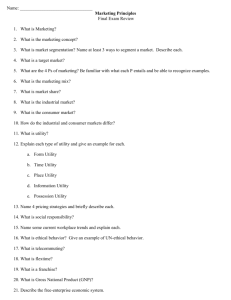
OPTIMAL TIME-OF-USE ELECTRICITY PRICING USING GAME THEORY
Peng Yang, Student Member, IEEE, Gongguo Tang, Member, IEEE, and Arye Nehorai, Fellow, IEEE
Preston M. Green Department of Electrical and Systems Engineering
Washington University in St. Louis, St. Louis, MO 63130, USA
ABSTRACT
Typical user demands of electricity vary throughout the day,
which increases the cost to utility companies and decreases
the stability of the power system. Time-of-use (TOU) pricing has been proposed as a demand-side management (DSM)
method to influence user demands. In this paper, we describe
a new approach of optimal TOU pricing strategy based on
game theory (GT-TOU). We propose models for costs due to
the fluctuating user demands to the utility companies, as well
as the user satisfaction measurement because of the difference between the demand and actual load. We design utility
functions for the company and the user, and obtain the Nash
equilibrium using backward induction and iterative methods.
Numerical example shows that our method is effective in leveling the user demand by setting optimal TOU prices, in potentially increasing the profit of the utility companies and ensuring overall user benefit.
Index Terms— Time-of-use, electricity price, game theory, optimization, smart grid
1. INTRODUCTION
The fluctuation of electricity demand throughout the day has
long been a problem for utility companies. During peak
hours, the utility companies face significant pressure to provide users with enough electricity, and may even have to
cut off the electricity supply of certain areas when the gap
between demand and generation is too large; while in offpeak hours, only a small number of generators are needed
to provide sufficient electricity to meet user demand, and the
idle generators result in a waste of generation capacity. The
utility companies wish to operate the power system on a base
load, on which the system is optimized, and therefore is the
most efficient. The base load is not the highest load that a
unit can provide, but operation far away from base load is
not cost efficient and may harm the stability of the power
system. Therefore, utility companies wish the user demand to
remain relatively “constant” during the day, so that they can
design and build generation units according to the “constant
demand”.
Time-of-use (TOU) pricing is an efficient way of demand
side management (DSM), which utility companies can em-
978-1-4673-0046-9/12/$26.00 ©2012 IEEE
3081
ploy to influence user behavior. By setting different prices
during the day, the utility company can encourage customers
to shift their demand to off-peak hours, resulting in a more
leveled demand curve. In [1], Caves et al. provides econometric analysis of a TOU pricing experiment in Wisconsin showing that short term electricity demand is not inelastic, and that
peak and off-peak electricity are partial substitutes. Hartway
et al. demonstrated in [2] through an experiment that TOU is
profitable to a utility, and in general, the customers are satisfied with the TOU price option. In recent years, time-of-use
pricing and real time pricing have attracted growing attention
both in academia and in industry [3]-[6], especially with the
development of smart grid, which enables the implementation
of time-dependent pricing.
We propose an optimal time-of-use pricing strategy for
smart grids using game theory (GT-TOU). A day is divided
into N periods, and the price is optimized for each time period. The goal is to influence the user behavior through TOU
pricing such that the load throughout the day is leveled. Because utility companies seek to maximize profits while users
seek minimized costs and assured supply, we consider a game
between utility companies and users using a multi-stage game
model. In this model, the utility company sets the electricity
prices, while the customers respond to the price by adjusting
the amount of electricity they use. Utility functions are designed for the company and the users, in which we take into
account the cost of varying demands to the utility company,
and the satisfaction measurement of users. Our pricing strategy is different from the real-time pricing in [5] and [6]. As
described in [5], users are not well prepared to respond to
the time-varying prices. Therefore, price prediction is often
required to implement real-time pricing [5], and energy management controller may be needed to help users manage their
power usage [6]. In contrast, in our model users are informed
of the price ahead of time, and the TOU prices remain stable
during a relatively long time unless there is significant change
in the characteristics of user demands or generation cost. We
believe these features would make our model easier to implement in practice.
The remainder of this paper is organized as follows:
Section 2 describes the notation and formation of the game
model; Sections 3 and 4 solve the equilibrium of the game;
a numerical example is given in Section 5; and the paper is
ICASSP 2012
3. If lk < dk :
concluded in Section 6.
sk (lk , dk ) > 0,
2. NOTATION AND MODEL
We divide a day into N periods, where N depends on the scenario of the application. For hourly based pricing N = 24.
Let c = [c1 , c2 , . . . , cN ]T denote the unit marginal cost of
electricity, p = [p1 , p2 , . . . , pN ]T denote the unit sales price
of electricity, g = [g1 , g2 , . . . , gN ]T denote the electricity
generation, d = [d1 , d2 , . . . , dN ]T denote the user demand in
a constant price scenario where the constant price is p0 , and
l = [l1 , l2 , . . . , lN ]T denote the actual user load in response to
the time-of-use price. The subscripts denote the corresponding time period.
We model the utility function of the company u1 as:
u1 =
N
pk l k −
k=1
N
ck gk − v(g)
In this paper we select sk (lk , dk ) as:
sk (lk , dk ) = βk [(
where v(g) corresponds to the cost caused by varying user
demand during the day. We model this cost using the variance
of electricity generation multiplied by a parameter μ, i.e.,
N
(gk − ḡ)2
,
(2)
v(g) = μ k=1
N
u2 = −C = −
C=
k=1
pk l k +
N
sk (lk , dk ),
(3)
k=1
where sk (lk , dk ) denote the user satisfaction function. The
user satisfaction function quantitatively models the user satisfaction caused by the gap between demand and actual load.
If the actual load is smaller than the demand, the function
value is positive, meaning the users are not satisfied. The satisfaction increases faster as the actual load decreases. On the
other hand, if the actual load is greater than the user demand,
the function value is negative, meaning the users are satisfied.
However, the increase of satisfaction slows down as the actual load continues to increase, because the users won’t be
“infinitely” happier when they use more electricity. When the
actual load equals the user demand, the function value is zero.
Therefore the satisfaction function sk (lk , dk ) should satisfy
the following conditions:
1. If lk = dk :
sk (lk , dk ) = 0.
2. If lk > dk :
∂sk
∂ 2 sk
sk (lk , dk ) < 0,
< 0, 2 > 0.
∂lk
∂ lk
N
k=1
(4)
pk l k −
N
sk (lk , dk ).
(5)
k=1
In this game model, we need to maximize the utility functions of both the company and the users. The optimization
problem is described as:
N μ
(gk − ḡ)2
(p∗ , g ∗ ) = arg max u1 = k=1 pk lk − ck gk − N
p,g
N l∗ = arg max u2 = − k=1 pk lk + βk [( dlkk )αk − 1]
l
subject to
where ḡ is the average electricity generation during the day.
The cost function C of users include the cost they pay for the
electricity and their satisfaction with the service, i.e.,
N
lk αk
) − 1],
dk
where 0 < αk < 1 and βk < 0. Other proper functions can
also be selected based on the nature and behavior of users.
The utility function of users is then the negative of their cost
function C, i.e.,
(1)
k=1
∂sk
∂ 2 sk
< 0, 2 > 0.
∂lk
∂ lk
0 ≤ lk ≤ gk ≤ gmax , k = 1, 2, . . . , N
ck ≤ pk , k = 1, 2, . . . , N .
In this preliminary work, we assume that the generation
equals user load, i.e., g = l, and that the actual load is less
than the generation capacity gmax . Then, the problem can be
simplified as:
N μ
(lk − ¯l)2 (6)
p∗ = arg max u1 = k=1 pk lk − ck lk − N
p
N ∗
l = arg max u2 = − k=1 pk lk + βk [( dlkk )αk − 1] (7)
l
subject to
ck ≤ pk , k = 1, 2, . . . , N
0 ≤ lk , k = 1, 2, . . . , N .
3. OPTIMIZING UTILITY FUNCTIONS
Since this is a multi-stage game, we use backward induction
[7] to solve for the equilibrium. The utility company takes
action first by setting the electricity price, and then customers
adjust the amount of electricity they use. Therefore, we first
minimize u2 with respect to {lk }N
k=1 , then plug the minimizer
into u1 and optimize u1 with respect to {pk }N
k=1 .
3.1. Optimal Demand Response to Price
In order to find user’s optimal demand response to the price
set by utility companies, we consider the electricity prices of
different time periods {pk }N
k=1 as given, and set the first order
3082
derivatives of u2 with respect to {lk }N
k=1 to be zero. Then we
as:
get the optimal response {lk∗ }N
k=1
lk∗ = (−
pk dk α 1−1
) k dk , k = 1, 2, . . . , N.
αk βk
(8)
The form of (8) is interesting as it reminds us of the price
elasticity of demand [8] in economics, which measures the
percentage change in demand quantity caused by percentage
change in price. Let denote the elasticity constant, d denote
the demand and p denote the price. The relationship between
change of price and change of demand can be described as:
∂d/d
= ,
∂p/p
Equation (13) provides an intuitive interpretation of the
optimal price p∗ . If the actual load lk at time period k is
higher than the average load ¯l, namely lk − ¯l > 0, then the
price is raised; if the actual load at time period k is lower than
average, i.e., lk − ¯l < 0, then the price is reduced.
4. SOLVING FOR THE EQUILIBRIUM
So far we have obtained p∗ and l∗ as functions of l∗ and p∗ ,
respectively, as follows:
p∗
k
=
lk∗
=
(9)
where is almost always negative, because in most cases
the increase of price will result in reduced demand, and vice
versa. We can also assume to be constant when the changes
of d and p are not too big. After integration on both sides and
simple computation, we obtain the following relationship:
p̃
d0 .
(10)
d˜ =
p0
k
c + 2μ · k (l∗ − ¯l∗ )
1+∗kkk N 1+k k
pk
dk , k = 1, 2, . . . , N
p0
(14)
The Nash equilibrium, which is the optimal strategy pair
(p∗ , l∗ ), can be obtained by solving (14). Since there are 2N
N
N
equations, {pk }N
k=1 depend on all {lk }k=1 , and {lk }k=1 are
,
it
is
extremely
difficult,
if not
not linear functions of {pk }N
k=1
impossible, to find a closed form solution. Therefore, we use
two iterative methods to solve (14) in this section.
4.1. Newton-Raphson iteration
d0 and p0 are the original demand and price, respectively, and
d˜ is the new demand corresponding to the new price p̃. It can
be observed that (8) is in exactly the same form as (10), if we
1
N
select parameters {αk }N
k=1 and {βk }k=1 such that k = αk −1
and p0 = −αk βk /dk . Equation (8) can then be rewritten as:
k
pk
∗
dk , k = 1, 2, . . . , N.
(11)
lk =
p0
In order to employ the Newton-Raphson iteration method, we
first reduce the number of equations by combining each equation pair. Plug (11) into (13) and then let
Note that dk and in (11) correspond to d0 and d˜ in (10),
respectively. We will use (11) instead of (8) in the rest of this
paper, because on the one hand, it will simplify the notation
for the rest of this paper; on the other hand, the parameters
have practical meanings.
(16)
fk (p) = pk −
k
k
2μ
·
ck +
(l∗ − ¯l∗ ).
1 + k
N 1 + k k
k
dk −
N 1 p i i
di .
N i=1 p0
(15)
and then we obtain
∂f (p)
,
∂pT
∂fk (p)
2μ
=1−
∂pk
N
where
1−
1
N
−1
2k pkk
dk ,
1 + k p0k
−1
∂fk (p)
2μ k i pi i
= 2
di , k = i.
∂pi
N 1 + k p0i
(17)
(18)
After that, we apply Newton-Raphson iteration to solve
for the optimal p∗ and l∗ :
1. Initialize p(i) = p(0)
−1
(i+1)
(p)
2. pk
= p(i) − ∂f
f (p)
T
∂p
3. Repeat 2 until p(i) − p(i−1) ≤ δ1 .
(12)
4.2. Alternating minimization
Plug (11) into (12), and let (12) equal zero, we obtain the
optimal price p∗ as a function of user response l∗ :
p∗k =
pk
p0
f (p) = [f1 (p), f2 (p), · · · , fN (p)]T ,
3.2. Optimal Pricing Based on User Response
∂lk
∂lk
∂u1
2μ
∂lk
(lk − ¯l)
= l k + pk
− ck
−
∂pk
∂pk
∂pk
N
∂pk
We now have only N equations {fk (g) = 0}N
k=1 . Denote
lk∗
In section 3.1 we obtained the optimal response of users to
electricity prices. In this section, we will maximize the utility
function of companies by finding the optimal pricing strategy
based on the user response. In order to maximize u1 , we take
derivatives of u1 with respect to {pk }N
k=1 . Note that in this
N
case, user loads {lk }N
k=1 are functions of the prices {pk }k=1 .
k
k
2μ
ck − ·
1 + k
N 1 + k
(13)
Although the Newton-Raphson method is fast in convergence, the convergence depends on the initial value and also
on the parameters. When the Newton-Raphson iteration has
convergence issues, we employ alternating minimization as
3083
greater gap between peak hour price and off-peak hour price
is set by utility companies to better influence user behavior.
Table 1 shows comparison of utility functions using constant
pricing and GT-TOU pricing, from which we conclude that
when applying GT-TOU prices: (i) the peak hour load significantly decreases; (ii) the utility functions of both the company
and users increase; and (iii) users pay a lower unit price for
the electricity.
6. CONCLUSION
Fig. 1: Comparison of customer prices and loads between
constant pricing and the proposed GT-TOU pricing.
Table 1: Comparison of company and user utility function
Strategy
Case 1
μ = 0.2
Case 2
μ = 1.0
Const.
GT-TOU
Const.
GT-TOU
Total
Load
433.50
448.89
433.50
450.26
Peak
Load
24.20
21.67
24.20
19.68
Unit
Price
1.040
1.018
1.040
1.008
u1
u2
227.46
230.40
200.94
227.93
-450.84
-435.51
-450.84
-448.91
We proposed an optimal time-of-use pricing strategy for electricity using game theory. We designed utility functions for
both utility companies and users, and solved for the Nash
equilibrium. The Nash equilibrium provides us with optimal
prices and user response. In practice, the parameters of the
model can be estimated using historic data from utility companies. This model is flexible, as we can modify the utility
functions according to the nature of different types of utility companies and users. Simulation results illustrate that our
strategy can level user demand, increase the profits of the utility companies, and reduce bills for electricity users. The leveled user demand also helps ensure a more stable power system. We are now incorporating different types of users, and
making the model of the cost to utility companies due to fluctuating user demands more realistic.
7. REFERENCES
an alternative way to solve (14), which works well for large μ.
(0) k
(i)
(0) (0)
dk ,
1. For each k: Initialize pk = pk , lk = pp0
¯l(0) = 1 N l(0) ;
k=1 k
N
(i)
(i−1)
c k k
k)
¯(i−1) ,
−
2. For each k: lk = N (1+
p
k
2μk
1+k + lk
(i) 1
k
¯l(i) = 1 N l(i) , and p(i) = lk
p0 ;
k=1 k
k
N
dk
3. Repeat 2 until lk − lk−1 ≤ δ2 .
5. NUMERICAL EXAMPLE
In this numerical example, we adopted hourly based pricing
by dividing a day into N = 24 equal time periods. Provided
the demands {dk }N
k=1 corresponding to constant price p0 , we
used the game based model to find the optimal pricing strategy and user load. The price elasticity was assumed to be
constant during the day and equals −2.0. We ran the simulation twice with different parameter μ selected as 0.2 and 1.0
respectively. The other parameters were set to be the same.
Fig.1 shows a comparison of prices and loads using constant and GT-TOU pricing. When using GT-TOU pricing, the
price is set higher in peak hours, and lower in off-peak hours.
The figure also illustrates the effect of cost due to fluctuating
user demands: when μ is large, such cost is high, and thus
3084
[1] D. W. Caves and L. R. Christensen, “Econometric analysis of
residential time-of-use electricity pricing experiments,” Journal
of Econometrics, vol. 14, pp. 287–306, 1980.
[2] R. Hartway, S. Price, and C. K. Woo, “Smart meter, customer
choice and profitable time-of-use rate option,” Energy, vol. 24,
pp. 895–903, 1999.
[3] A. K. David and Y. Z. Li, “Effect of inter-temporal factors on the
real time pricing of electricity,” IEEE Trans. Power Syst., vol. 8,
pp. 44–52, 1993.
[4] Q. Wu, L. Wang, and H. Cheng, “Research of TOU power
price based on multi-objective optimization of DSM and costs of
power consumers,” in International Conference on Electric Utility Deregulation, Restructuring and Power Technologies, Hong
Kong, Apr. 2004, pp. 343–348.
[5] A.-H. Mohsenian-Rad and A. Leon-Garcia, “Optimal residential
load control with price prediction in real-time electricity pricing environment,” IEEE Trans. Smart Grid, vol. 1, pp. 120–133,
2010.
[6] C. Chen, S. Kishore, and L. V. Snyder, “An innovative RTPbased residential power scheduling scheme for smart grids,” in
ICASSP, Prague, Czech Republic, May 2011, pp. 5956–5959.
[7] D. Fudenberg and J. Tirole, Game Theory.
sachusetts: The MIT Press, 1991.
Cambridge, Mas-
[8] K. F. Case and R. C. Fair, Principles of Economics, 8th Ed.
New Jersey: Pearson Prentice Hall, 2007.





